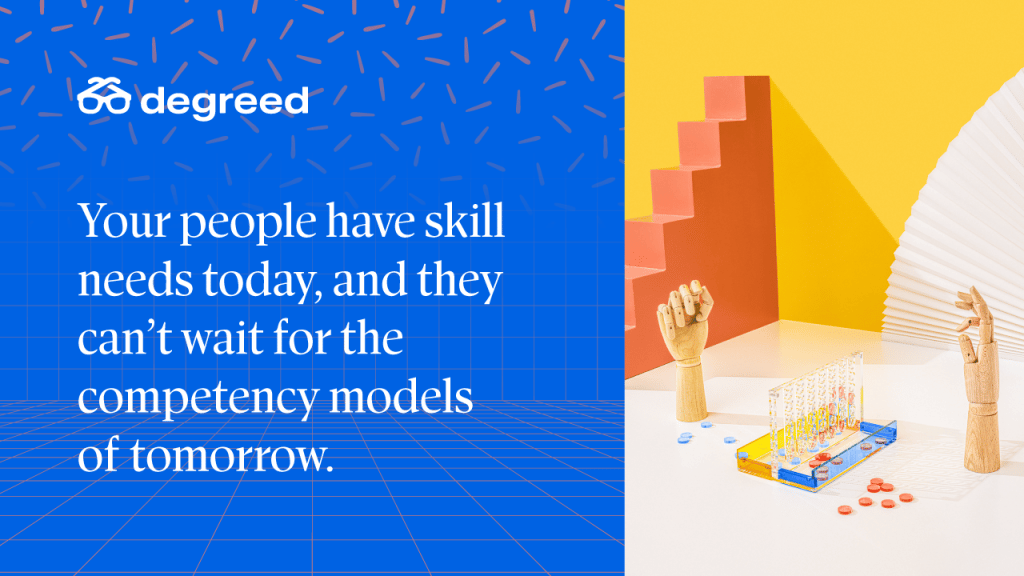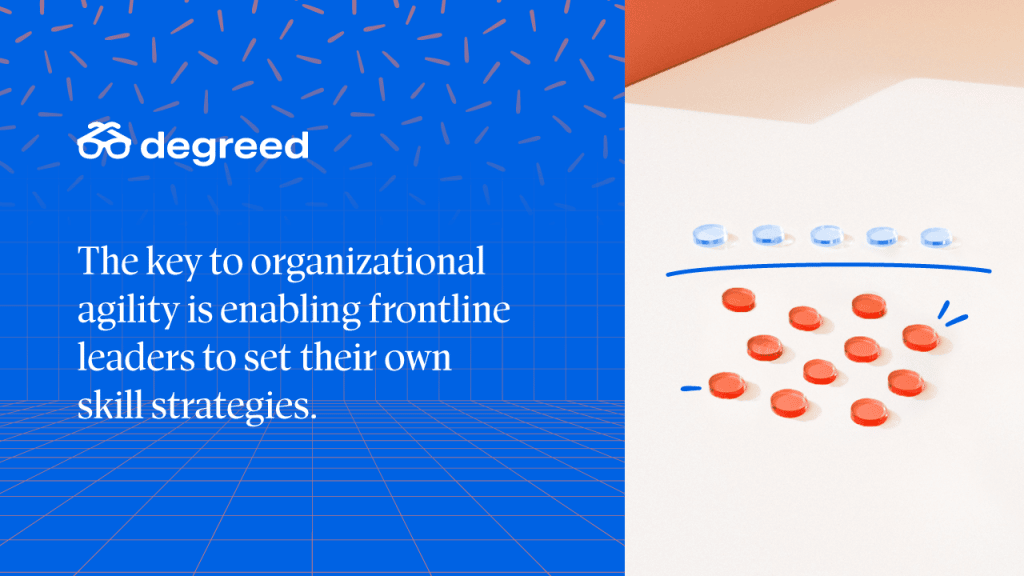If you’ve been in the learning and talent space long enough, you’ve probably created a competency model, which leaves little room for organizational agility. For those of you unfamiliar, creating a competency model usually goes something like this:
- A role is identified as lacking up-to-date (or any) skill definition
- Lots of assessments and interviews are conducted with a variety of stakeholders
- Maybe a consultant is brought in
- A draft map is created and shared back to all stakeholders for feedback and wordsmithing
- At long last, a shiny new plan is written to share the model with workers and their managers, but not always with clear expectations of what to do with it

This process often takes months and sometimes close to a year. Now, apply that process across hundreds or even thousands of roles in your organization, and you see the challenge many organizations face today. It’s a common misconception that all of this mapping, defining, and taxonomy building is a prerequisite to an impactful skill strategy.
While planning for a long-term and well-defined skills ecosystem at your organization is important work, it shouldn’t prevent anyone from taking action to build skills right now — and that’s what it means to have organizational agility. Your people have skill needs today. They can’t wait for the competency models of tomorrow.
Then vs. Now
The key to organizational agility is enabling and empowering frontline leaders and workers to set and carry out their own skill strategies.
In the past, defining and driving a skills strategy fell primarily to a central L&D team, and the primary focus was defining and mapping skills across various roles. This often led to more documentation than development — including lengthy PDFs and slide decks covering every skill and each level within those skills, but not a clear indication of where and how to get started actually building those skills. Many competency models also have 20 to 30 skills associated with them, far too many to develop all at once. How would a worker know where to start?

Often, the first people to recognize a skill gap are those closest to the realities of the work. They see first-hand the changes in their markets, their workers, and their strategies. 87% of respondents in a McKinsey Global Survey say they either are experiencing gaps now or expect them within a few years.
Imagine if those people had the tools and the confidence to start addressing skill needs as soon as they arise (or even before) rather than waiting for L&D to define and solve all skill needs for them. This organizational agility would allow workers to quickly identify and assess their own skill needs, and start developing themselves without needing a manager or L&D to sign them up for the next round of formal training.
Decentralize and Democratize
Democratizing your skill strategy and allowing leaders and workers to develop and iterate skill journeys in real time allows you to improve multiple elements of your learning culture:
Agility — If a leader or worker recognizes a skill gap, it’s likely already causing some business or performance pain. If they have to wait for a top-down solution, that pain remains unaddressed and will likely get worse. Markets, customers, technology, and ways of working are changing faster than ever, and we need skill development to be able to react just as quickly. Empowering leaders and workers to set their own skill priorities allows them to adjust to changes in real time.
Relevancy — When skills are prioritized for people at the local level, the connection to their day-to-day is clearer than a one-size-fits-all competency model that covers everything. If skills are prioritized at a global or even functional level that’s removed from a worker’s day-to-day work and team, that person will be less likely to buy into the importance of those priorities.
Engagement — According to Degreed research, the top two barriers to learning at work is lack of manager encouragement and lack of guidance or direction. In short, manager involvement and guidance are crucial in learning engagement.
Data — Allowing workers and leaders to set their own skill strategies creates a wealth of skill data that your organization might currently lack. By empowering frontline workers to identify their own skill needs, you can essentially crowdsource competency frameworks and skill priorities from those closest to the challenge rather than try to infer the skills people need from the top down.
While adopting this more decentralized approach to skills may seem daunting, the good news is that Degreed is perfectly built to make it easy for your workers and leaders to own their skill destinies. Degreed enables leaders to quickly assess, develop, and track team skill growth while leveraging internal expertise to curate learning solutions quickly. People can set personal skill goals and explore your company’s entire learning and talent ecosystem for the best content, SMEs, groups, and opportunities for chosen skills.
All of this can begin the moment the skill need is identified, without needing to wait for a formal L&D solution to be designed and built. Degreed essentially makes every employee and leader in your organization a part of the L&D team rather than a passive recipient. And as skills are built all across your organization at the individual and team level, not only are you enabling organizational agility, but your company is also generating lots of data on existing skill levels and gaps, internal SMEs, most relevant content and providers, and more.

The First Steps Towards Organizational Agility
Now, you may be wondering if this democratized approach to skill building diminishes the importance of a central L&D function. But here’s the good news: it does the exact opposite.
First, your global L&D team will still own the development of skills that are consistently in demand across your organization, including leadership models, core values, and org-wide strategic skills.
But more importantly, L&D will be the architect for this new environment, in which leaders and workers are enabled and empowered to take on their own skill challenges. Rather than the old way of L&D feeling like order takers that need to solve all learning problems, the new objective is to teach people to “fish for themselves” when it comes to learning, and to make sure they have the skills and tools to be successful.
Here are a few key activities your central L&D team can focus on as part of this broader culture shift towards organizational agility:
Shape the environment — L&D can ensure leaders understand the tools and processes at their disposal to tackle the skills challenges most important to them. Tools like Degreed are a critical component, but ensuring access to content, data, and other resources is equally important.
Change mindsets — When workers understand that they are empowered to solve their own skill problems, L&D can equip them with the technology, data, and resources to address skill needs as soon as they arise. Individuals are encouraged to take the responsibility for driving the solution and understanding how to directly connect skill needs to business challenges. L&D becomes an internal consultant and coach to help individuals and team leaders shape their nascent skill strategies. And Degreed research suggests that your workforce will need that guidance.
Amplify internal success cases — L&D can find the early champions or business areas that are owning their skill development and share those examples across your organization. Marketing great use cases and success stories helps teams learn from each other while recognizing and rewarding the teams that are innovating and succeeding.
Connect the dots — L&D has an opportunity to identify and align teams focused on the same challenges. If three different parts of your organization are all trying to develop data analytics skills at the same time, L&D can help connect their initiatives to gain efficiencies and increase overall quality.
Changing your learning culture to create more ownership and empowerment will take time.
Rather than attempt to shift your entire organization to this new approach, start with a focused initiative partnering with just one part of your organization.
Identify a function, team, or leader that already has a clear challenge and a desire to take ownership of the solution. Partner closely with that function to bring this agile and empowered approach to skills to life, so they can serve as an example that helps to bring the rest of your organization on board.
Want to Learn More?
Download our new guide, 4 Ways Every Manager Can Create a Positive Learning Culture, to discover what managers can do to build a positive learning culture.

